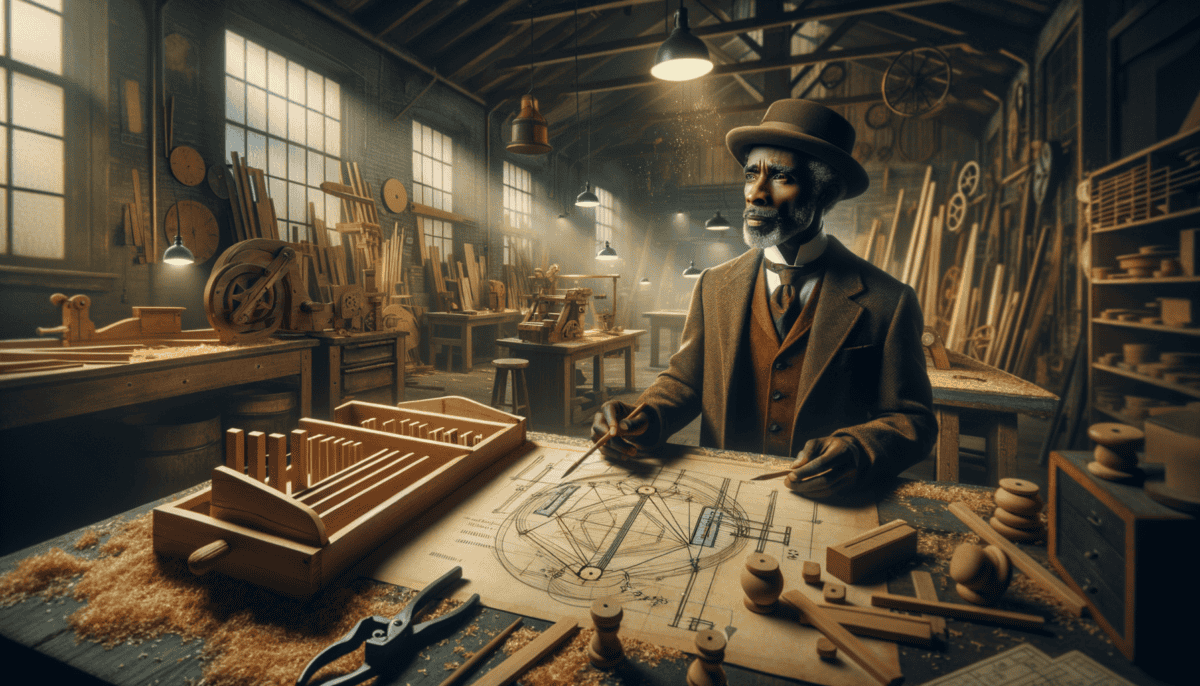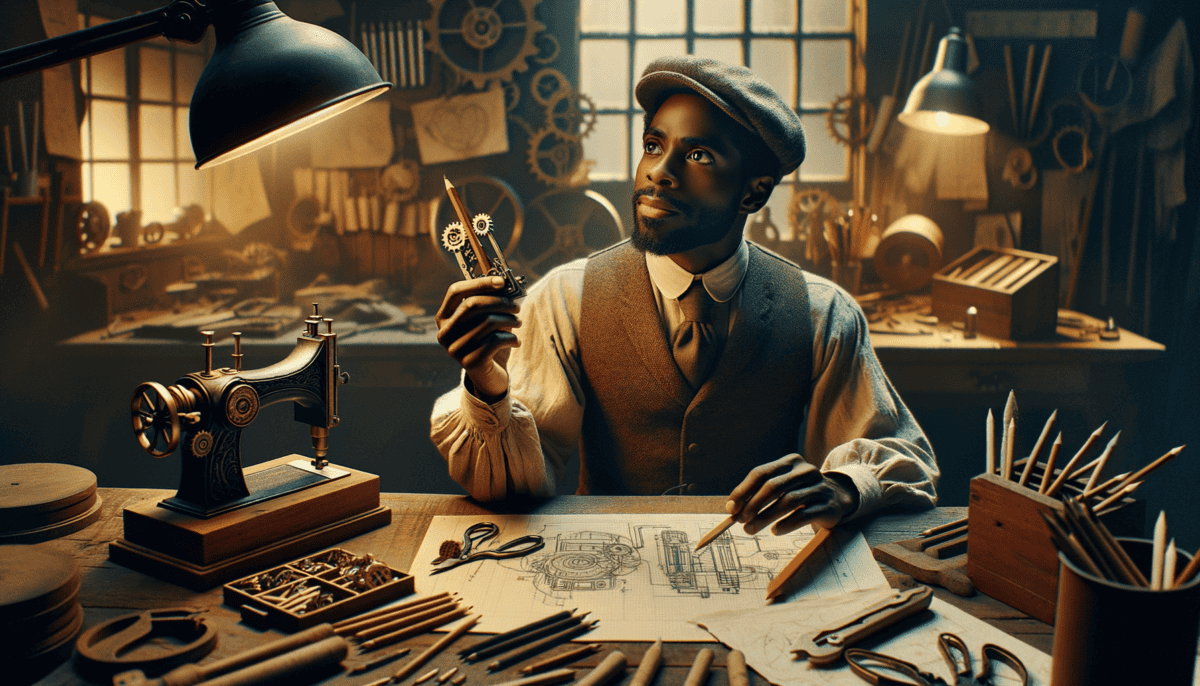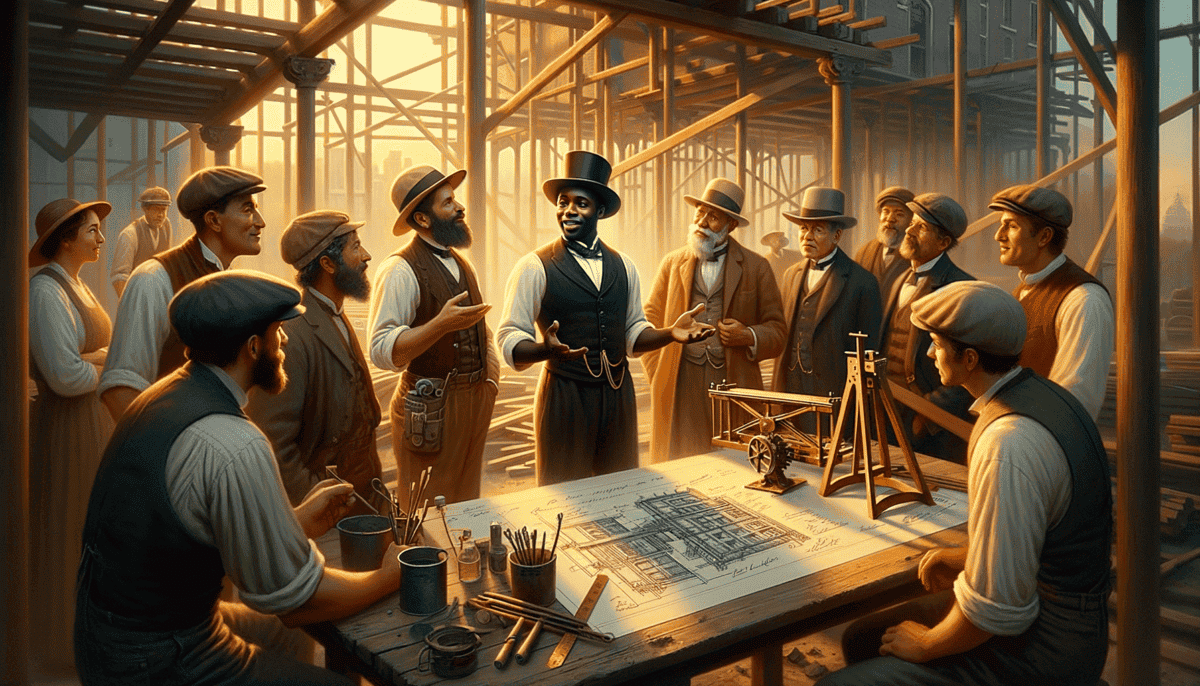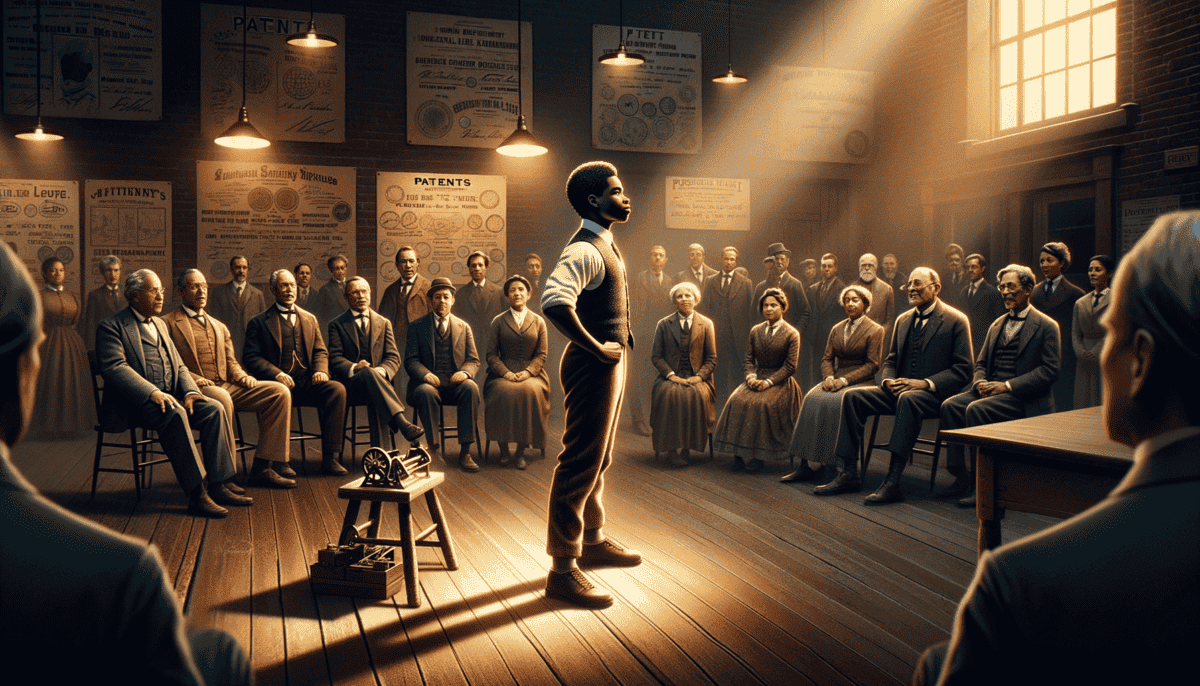A Young Mind Dreams Big
Little John Lee Love sat on his front porch, watching the sunset paint the sky orange. His fingers were always busy, whittling pieces of wood into tiny shapes. Even at eight years old, he saw the world differently from other kids.
"Whatcha making there, John?" his mama called from the doorway.
"Something special, Mama!" he replied, his eyes twinkling with excitement. "I'm trying to make a bird that can really fly!"
The year was 1877, and young John lived with his family in a small house in Fall River, Massachusetts. While other children played simple games, John preferred to create things with his hands.
“I believe anything can be made better,” John would often say, even as a child. “We just have to figure out how!”
His daddy was a carpenter, and John loved spending time in his workshop. The smell of fresh sawdust made him feel at home. Every day after school, he would rush to watch his father work.
"Papa, can I help?" John would ask, bouncing on his toes with excitement.
His father smiled, handing him a small piece of wood. "Here, son. Remember what I taught you about sanding?"
First Steps to Creating
John's first creation was a simple wooden toy car. It wasn't perfect – the wheels were a bit wobbly, and the paint was messy. But his eyes shone with pride when he showed it to his family.
"Look what I made!" he announced at dinner one evening, placing the toy car carefully on the table.
His older sister Mary picked it up, turning it in her hands. "It actually rolls!" she exclaimed, giving it a gentle push across the table.
Life wasn't always easy for the Love family. Being African American in the late 1800s meant facing many challenges. But John's parents taught him something important:
Each night, John would lie in bed, thinking about new things to make. He kept a small notebook under his pillow, where he drew pictures of his ideas. Sometimes they were simple things, like a better way to hold his school books. Other times, they were grand inventions that made his family laugh with delight.
One day, while struggling with a dull pencil at school, young John had an interesting thought. "There must be a better way to sharpen pencils," he mumbled to himself, already sketching in his notebook.
His teacher, Miss Thompson, noticed his distraction. Instead of scolding him, she smiled and said something that would stick with him forever:
“Sometimes the best ideas come from the simplest problems, John. Keep thinking that way.”
As John grew, so did his understanding of tools and materials. He learned to use his father's carpentry tools with care and precision. Every mistake became a lesson, and every success fueled his desire to create more.
His mother would often find him in the backyard, testing his latest creation. Sometimes they worked, and sometimes they didn't. But John never gave up. Each failure just made him more determined to succeed.
"Mama," he said one evening, helping her with the dishes, "I'm going to invent things that help people. Things that make their work easier."
She hugged him tight and said, "I believe you will, John. I truly believe you will."
Those childhood days shaped John Lee Love into someone special. Each splinter in his fingers, each hour spent watching his father work, and each encouraging word from his family built the foundation for his future as an inventor.
The sun set on many such days in Fall River, as young John dreamed and created. His simple wooden toys would one day lead to inventions that would help people for generations to come. But for now, he was just a boy with big dreams, sitting on his porch, whittling wood and imagining what could be.
Building Dreams from Wood and Steel
The workshop buzzed with energy as John Love, now a young man, carefully guided a piece of wood through the saw. Sawdust danced in the sunlight streaming through the windows.
“Perfect cut,” he mumbled to himself, running his fingers along the smooth edge. At twenty-two, John had become a skilled carpenter, just like his father.
But John wasn’t just making furniture. His mind was always working on new ideas. In his pocket, he carried a small notebook filled with sketches of inventions.
“Every tool can be made better,” John would say to his fellow carpenters. “We just need to think differently.”
Finding Problems to Solve
One busy morning, John watched his coworker struggle with a heavy plasterer’s hawk – the tool used to hold plaster while working. The man’s arms shook from the weight.
“There’s got to be a better way,” John thought, quickly sketching in his notebook. That night, he stayed late in the workshop, experimenting with different designs.
But being an inventor wasn’t easy, especially for an African American man in the late 1800s. When John tried to share his ideas at the local tool shop, some people wouldn’t even look at his drawings.
“Don’t let them stop you,” his father advised. “Your ideas are good, son. Keep going.”
Learning About Patents
One day, John met Mr. Thompson, an older carpenter who had patented a tool years before. Their conversation changed everything.
“You need to protect your ideas, John,” Mr. Thompson explained. “That’s what patents are for.”
“But how do I get one?” John asked eagerly.
“It’s not easy,” Mr. Thompson warned. “You’ll need detailed drawings, descriptions, and money for fees. But I’ll help you learn.”
“Knowledge shared is knowledge multiplied,” Mr. Thompson would say during their evening lessons about patent law.
John spent his evenings studying patent applications. He learned about technical drawings and legal descriptions. Every penny he saved went toward his dream of becoming an inventor.
His first invention attempt was a simple tool holder. It didn’t work quite right, but John learned from the experience. Each failure taught him something new.
The Workshop Becomes a Laboratory
John turned a corner of his workshop into an invention space. He called it his “thinking corner.”
Here, surrounded by tools and sketches, he would work late into the night. Candles cast dancing shadows as he tested new ideas.
• Wood carving tools
• Metal working equipment
• Drawing supplies
• Testing materials
“What are you working on now?” his sister Mary would ask when she brought him dinner.
“Something special,” he’d reply with a smile. “Something that will help people work better.”
Word spread about John’s talent for solving problems. Other workers started coming to him with their tool troubles.
“Could you make this hammer grip better?”
“Is there a way to make this saw lighter?”
Each question sparked new ideas in John’s mind. He filled notebook after notebook with designs and improvements.
Dreams Taking Shape
One evening, as John walked home from work, he passed a school. Through the window, he saw children struggling with their pencil sharpeners. The memory of his own childhood struggles came flooding back.
“Still using those clumsy sharpeners,” he thought. “Maybe I could…” His hand was already reaching for his notebook.
That night, under the warm glow of his workshop lantern, John began sketching what would become one of his most important inventions. But first, he had more to learn about patents, more skills to master, and more obstacles to overcome.
The road ahead would be challenging, but John Lee Love was ready. His hands were strong from years of carpentry, his mind was sharp from solving problems, and his heart was full of determination to make the world a little better through his inventions.
The Perfect Point of Innovation
John Love stood at his workbench, holding a broken pencil sharpener. School children’s frustrated faces flashed in his mind.
“There has to be a better way,” he muttered, turning the broken device in his hands.
A Simple Idea Takes Shape
John grabbed his notebook and started drawing. His pencil flew across the paper as ideas poured out. He thought about how children struggled with big, heavy sharpeners stuck to classroom walls.
“Small enough to carry, but strong enough to work well,” he whispered to himself.
Night after night, John worked in his workshop. He used his carpentry skills to make wooden models. Each one taught him something new.
The first model was too big:
“No, that won’t fit in a pocket.”
The second was too weak:
“The blade needs to be stronger.”
The third couldn’t hold the shavings:
“We need a way to catch the mess.”
Building the Perfect Sharpener
Finally, after many tries, John held up a small wooden cylinder. It was just bigger than his thumb. Inside was a clever system of blades and a tiny container for shavings.
• Small and portable
• Built-in shaving catcher
• Sharp, durable blade
• Easy to clean
“Try this,” John said to his niece Sarah, handing her a dull pencil and his new invention.
Sarah’s eyes widened as she turned the pencil. “Uncle John, look! It works perfect!”
The point was sharp and clean. No mess scattered on the floor. No running to the big sharpener on the wall.
The Patent Journey
John knew his invention was special. He remembered Mr. Thompson’s lessons about patents. Now it was time to put them to use.
First, he made detailed drawings showing every part of his sharpener. His hands, steady from years of carpentry, drew each piece carefully.
“The blade sits here,” he wrote. “The shavings collect there.”
Writing the patent application was hard work. John spent hours finding the right words to describe his invention. He wanted everyone to understand how it worked.
“Clear words make clear patents,” Mr. Thompson had taught him.
Waiting and Hoping
The patent office received John’s application in November 1897. Now came the hard part – waiting. ️
John kept working in his carpenter shop during the day. But at night, he made more sharpeners. Each one was a little better than the last.
Children from the neighborhood would stop by his workshop:
“Mr. Love, can we try your new sharpener?”
“Of course,” he’d smile, watching their faces light up.
The Big News
Finally, on a cold winter morning, a letter arrived from the patent office. John’s hands shook as he opened it.
“Patent Granted!” the letter declared. John’s portable pencil sharpener was now officially recognized. The date was November 23, 1897.
That night, John held the patent paper carefully. His simple idea could now help people everywhere. But he wasn’t done inventing yet. Another idea was already forming in his mind – one that would help workers like himself.
The portable pencil sharpener was just the beginning. John Lee Love’s creative mind was already racing toward his next invention.
Building Better Tools
The sun rose over John Love’s workshop as he watched construction workers struggle with their heavy tools. ️
A plasterer’s hawk was a flat board workers used to hold plaster. But the old ones were too heavy. Workers got tired quickly.
A Worker’s Pain
“How’s your shoulder today, Ben?” John called out to his friend at the construction site.
Ben rolled his sore shoulder. “Same as always, John. This hawk feels like it weighs a ton by lunch time.”
“What if I could make it lighter?” John asked. “And what if you could take the handle off when you’re not using it?”
Ben’s eyes lit up. “That would be amazing! But can you really do it?”
“I can try,” John smiled, already sketching ideas in his mind.
Back to the Workshop
John’s workbench soon filled with different materials. He tried wood first, but it was still too heavy. Then metal, but it wasn’t quite right.
• Light weight
• Strong enough for plaster
• Removable handle
• Easy to clean
“What about this new material called plastic?” John wondered. He’d heard about it from a traveling salesman.
After getting some samples, John knew he’d found his answer. Plastic was perfect – light but strong!
Testing Time
John brought his first prototype to the construction site. “Try this, Ben!”
Ben’s eyes went wide as he lifted the new hawk. “It’s so light! And look at this handle – it comes right off!”
Other workers gathered around:
“Can I try it?”
“Where can I get one?”
“My arms won’t be so tired with this!”
Making It Official
John knew he had another winner. This time, writing the patent was easier. He’d learned a lot from his pencil sharpener experience. ✍️
“A lightweight plasterer’s hawk with a detachable handle,” he wrote carefully. “Designed to reduce worker fatigue and increase efficiency.”
The patent office received his application quickly. While waiting, John made more hawks. Each construction site in town wanted to try them.
Success Spreads
Word about John’s new tool spread fast. Construction companies started asking about bulk orders. Workers told their friends on other sites.
The patent was approved! Now construction workers everywhere could use John’s better tool.
But more than just making money, John felt proud. He’d helped make workers’ lives easier. Their smiles and thanks meant more than any patent paper.
As he watched workers using his hawk, John’s mind was already turning to new problems to solve. What else could he make better?
Standing Strong
The morning newspaper landed on John Love’s doorstep with a thud. The year was 1895, and times were hard for African American inventors.
His pencil sharpener and plasterer’s hawk sat on his workbench, shining in the morning light. They were good tools. They helped people. But some folks didn’t want to see past the color of his skin.
A Friend’s Voice
“You going to try, John?” asked Sarah, his neighbor’s daughter. She loved watching him work.
“I sure am, little one,” John smiled. “Sometimes you have to be brave to make things better.”
“My teacher uses your pencil sharpener,” Sarah said proudly. “She says it’s the best one she’s ever had!”
The Inventor’s Fair
The fair was busy when John arrived. People crowded around tables full of new inventions.
Some folks frowned when he set up his display. Others walked past without looking. But John stood tall.
• Working pencil sharpener
• Lightweight plasterer’s hawk
• Clear drawings of how they work
• Samples for people to try
Making Believers
A teacher stopped at John’s table. She picked up the pencil sharpener.
“This is wonderful!” she exclaimed. “So simple to use!”
More people gathered around. They watched as John showed how his tools worked.
“Who made these?” asked a man in a fancy suit.
“I did, sir,” John said proudly. “I saw problems that needed fixing, so I fixed them.”
Breaking Through
John’s heart jumped. Finally, someone saw his work, not his skin color!
More store owners came by. They all wanted John’s inventions. His tools would help even more people now.
Sharing Success
That evening, John visited the local school. Black children sat wide-eyed as he showed them his inventions.
“Don’t let anyone tell you what you can’t do,” he told them. “If you see something that needs fixing, fix it. The world needs your ideas.”
A small boy raised his hand. “But what if people say no?”
“Then you try again,” John said softly. “And again. Good ideas can’t be stopped.”
Forward Motion
More orders came in for John’s tools. More people wanted to meet the inventor.
But John wasn’t done. He kept working, kept thinking, kept creating. Each success made the path a little easier for others to follow.
As he walked home that night, Sarah waved from her porch.
“Did you show them, Mr. Love?” she called out.
John smiled. “I sure did, Sarah. I sure did.” ⭐
A Lasting Light
Years passed, and John Lee Love’s inventions brightened more lives every day. ✨ His pencil sharpener found homes in schools across America, while his plasterer’s hawk helped builders work faster and better.
John smiled at his granddaughter. He was older now, his hair gray, but his eyes still sparkled with the same creativity.
Seeds of Change
One sunny morning, John visited a classroom filled with eager faces – children of all colors sitting together, learning and creating.
“Who wants to be an inventor?” John asked. Every hand shot up, reaching for the sky like flowers stretching toward the sun.
“Remember,” he told them, “every big idea starts small. Just like my little pencil sharpener that now helps millions of people.”
The Ripple Effect
• Students could sharpen pencils anywhere
• Workers finished jobs faster with better tools
• Other inventors felt inspired to follow their dreams
• Schools became more efficient
Sarah, now grown with children of her own, still lived next door. She became a teacher and used John’s pencil sharpener every day.
Building Bridges
One day, a letter arrived from the Patent Office in Washington. They wanted to display John’s inventions in their museum! ️
John thought about his journey – from a curious boy to a respected inventor. He thought about all the doors that had been closed, and all the windows he’d climbed through instead.
The Next Generation
Young inventors started visiting John’s workshop. They brought their ideas and dreams, just like he once had.
“Never let anyone dim your light,” he told them. “The world needs every bright idea you have.”
A Beautiful Legacy
John’s tools kept working, year after year. His pencil sharpener design was so good, people still use something like it today!
Schools named invention clubs after him. Construction workers told stories about his plasterer’s hawk. Children drew pictures of new ideas, inspired by his courage.
Even when John grew too old to work in his shop, his spirit of invention lived on. Every sharpened pencil, every smoothly plastered wall carried a piece of his dream.
Forever Bright
On warm evenings, John would sit on his porch, watching children play with toys they’d made themselves. Each one was an inventor, just like him.
His granddaughter climbed onto his lap, holding a drawing of her own invention – a special cup that wouldn’t spill.
“Can we make it, Grandpa?” she asked.
John hugged her tight. “Of course we can, sweetheart. That’s what inventors do – we make dreams come true.”
And somewhere, in workshops and classrooms across America, new inventors were picking up their perfectly sharpened pencils, ready to draw their own bright futures. ⭐






